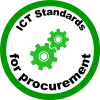Interoperability is insufficiently taken into account in public procurement. It is an external cost often ignored but which could be made part of the total lifecycle cost. It can help reduce the impacts of vendor lock-in
The new procurement Directive 2014/24/EU offers concepts that support a more holistic approach to costs:
- Use of ‘most economically advantageous tender’ (MEAT) as default criteria (Art. 67). When transposing the Directives, member states may choose to forbid or restrict the use of lowest price as the sole award criterion.
- The use of life cycle costing (LCC) as a method for assessing tender costs is clarified (Art. 68). Contracting authorities may select to include costs imputed to externalities in this calculation.
The externalities that can be imputed under LCC can refer to societal challenges such as environment but can also refer to other types of external costs such as the lack of interoperability. Interoperability removes the costs associated with linking to incompatible systems. It is a principle of both the EU eGovernment Action plan principles and the European Interoperability Framework.
To increase interoperability, the Catalogue facilitates the use of standards in procurement (more here) and the reuse of digital services (more here). Also, the Catalogue provides interoperability guidelines and it invites practitioners to submit national guidelines, applied practices, or experiences on procuring interoperable services. When guidelines exist to integrate the lack interoperability in MEAT or LCC, this will be indicated.
As part of Action 23 of the Digital Agenda , the European Commission has developed guidance on the link between ICT standardisation and public procurement to help public authorities to use open standards to promote efficiency and reduce lock-in. In 2013, the Commission adopted the Communication on standardisation and public procurement. One of the findings following a survey of procuring authorities conducted under Action 23 shows that at least 40% of respondents perceive some degree of vendor lock-in arising from either (a) a lack of interoperability and compatibility between existing and new systems or solutions, or (b) from a lack of transferability of data and information between old and new systems. Lock-in arising from institutional factors (e.g. staff familiarity with existing products) was noted by 25 per cent of respondents; and lock-in arising from service providers was noted by just under 20 per cent of respondents.
Where relevant, the EU Catalogue will refer to the findings of the above initiative and other guidelines to reduce lock-in.

